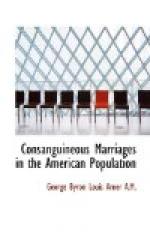A very ingenious method of determining the approximate number of first-cousin marriages was devised by Mr. George H. Darwin.[24] Noticing that in marriage announcements, some were between persons of the same surname, it occurred to him that there might be a constant ratio between same-name marriages and first cousin marriages. Some same-name marriages would of course be purely adventitious; so, to eliminate this element of chance, he obtained from the Registrar General’s Report the frequency of occurrence of the various surnames in England. The fifty commonest names embraced 18 per cent of the population. One person in every 73 was a Smith, one in every 76 a Jones and so on. Then the probability of a Smith-Smith marriage due to mere chance would be 1/73^2 and of a Jones-Jones marriage 1/76^2. The sum of fifty such fractions he found to be .0009207 or .9207 per thousand. After the fiftieth name the fractions were so small as to have comparatively little effect upon the total. He therefore concluded that about one marriage in a thousand takes place, in which the parties have the same surname and have been uninfluenced by any relationship between them bringing them together.
[Footnote 24: “Marriages between First Cousins in England and their Effects,” in Journal of the Statistical Society, June, 1875. pp. 154 et seq.]
The next step was to count the marriages announced in the “Pall Mall Gazette” for the years 1869-72 and a part of 1873. Of the 18,528 marriages there found, 232 or 1.25 per cent were between persons of the same surname. Deducting the percentage of chance marriages at least 1.15 per cent were probably influenced directly or indirectly by consanguinity.
Mr. Darwin then proceeded by a purely genealogical method. He found that out of 9,549 marriages recorded in “Burke’s Landed Gentry,” 144 or 1.5 per cent were between persons of the same surname, and exactly half of these were first cousins. In the “English and Irish Peerage” out of 1,989 marriages, 18 or .91 per cent were same-name first cousin marriages. He then sent out about 800 circulars to members of the upper middle class, asking for records of first cousin marriage among the near relatives of the person addressed, and obtained the following result:
----------------------------------------------- Same-name first cousin marriages | 66 Different-name first cousin marriages | 182 Same-name not first cousin marriages | 29 -----------------------------------------------
These cases furnished by correspondents he calculated to be 3.41 per cent of all marriages in the families to which circulars were sent.
From the data collected from all these sources Mr. Darwin obtains the following proportion:
Same-name first cousin marriages 142 -------------------------------- = --- = .57 All same-name marriages 249
He is inclined to think that the ratio should be lower and perhaps .50 instead of .57. By a similar line of reasoning he obtains this proportion:




